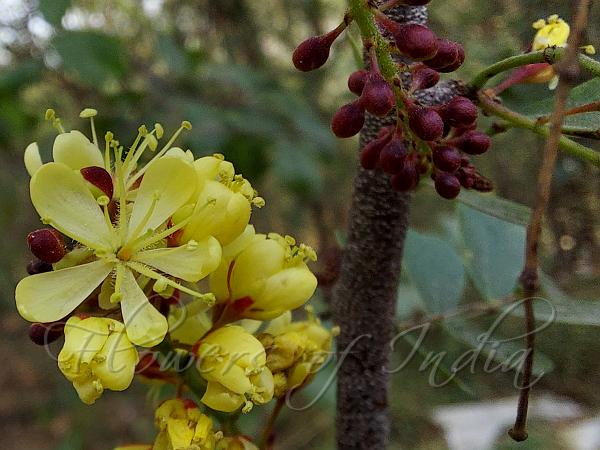|
| Bloodwood Tree |
|

|

| File size | 490989 |
| Original date | 12/31/20 1:39 PM |
| Resolution | 2576 x 1160 |
| Flash | Flash did not fire |
| Focal length | 2.13mm |
| Exposure time | 1/171s |
| Aperture | 2.4 |
| Focus Distance | |
| Metering Mode | Spot |
| Camera make | samsung |
| Camera model | SM-M515F |
| Sensor type |
|
|
|
|
Photo: |
Botanical name: Haematoxylum campechianum Family: Fabaceae (Pea family)
Synonyms: Acosmium trichonema, Cymbosepalum baronii
Synonyms: Acosmium trichonema, Cymbosepalum baronii
Bloodwood Tree is a slow-growing, small, bushy,
semi-deciduous tree with a broad crown. It is often thorny and gnarled
in appearance; the bole irregularly fluted and contorted, attaining a
length of 2-3 m and a diameter of 60 cm, bark grey to brown, rather
smooth, peeling in flakes. Leaves are alternate, paripinnate; stipules
partly spine-like; leaflets in 2-4 pairs, obovate, 1.0-3.5 x 0.5-2.5
cm, pointed at base, closely veined and hairless. Flowers are arranged
in 5-20 cm long racemes in the axils leaves, 5-merous, sweet-scented;
sepal-cup 4-5 mm long, deeply lobed. Petals are 5-7 mm long, bright
yellow; stamens 10, free; ovary superior, shortly stalked, hairless;
style thread-like. The fruit is a lanceshaped, extremely flattened pod,
3-5 cm long, pointed at both ends, splitting not along the sutures but
along the median of the sides, usually 2-seeded. The tree is valued
particularly as a source of dye material, but is also often used
locally as a medicine and source of wood. It is cultivated as a dye
plant in several tropical countries of the Americas, Africa and
elsewhere, and has become naturalized in some places. It is native to
S. Mexico to Honduras.
Medicinal uses: The wood is anodyne,
antiinflammatory, mildly astringent, blood purifier, digestive,
febrifuge, haemostatic and tonic. It is prescribed in the form of a
decoction and liquid extract. It is considered useful against a range
of conditions including diarrhoea, dysentery, atonic dyspepsia and
leucorrhoea. Externally, it is used as an astringent disinfectant for
wounds and skin ulcers. An ointment prepared from the wood is said to
be useful against cancer and hospital gangrene.
The wood is anodyne,
antiinflammatory, mildly astringent, blood purifier, digestive,
febrifuge, haemostatic and tonic. It is prescribed in the form of a
decoction and liquid extract. It is considered useful against a range
of conditions including diarrhoea, dysentery, atonic dyspepsia and
leucorrhoea. Externally, it is used as an astringent disinfectant for
wounds and skin ulcers. An ointment prepared from the wood is said to
be useful against cancer and hospital gangrene.
Medicinal uses:
 The wood is anodyne,
antiinflammatory, mildly astringent, blood purifier, digestive,
febrifuge, haemostatic and tonic. It is prescribed in the form of a
decoction and liquid extract. It is considered useful against a range
of conditions including diarrhoea, dysentery, atonic dyspepsia and
leucorrhoea. Externally, it is used as an astringent disinfectant for
wounds and skin ulcers. An ointment prepared from the wood is said to
be useful against cancer and hospital gangrene.
The wood is anodyne,
antiinflammatory, mildly astringent, blood purifier, digestive,
febrifuge, haemostatic and tonic. It is prescribed in the form of a
decoction and liquid extract. It is considered useful against a range
of conditions including diarrhoea, dysentery, atonic dyspepsia and
leucorrhoea. Externally, it is used as an astringent disinfectant for
wounds and skin ulcers. An ointment prepared from the wood is said to
be useful against cancer and hospital gangrene. | Identification credit: N Arun Kumar | Photographed in Aurangabad, Maharashtra. |
• Is this flower misidentified? If yes,